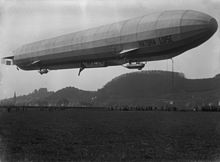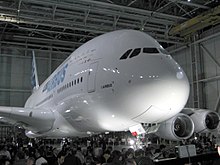Passenger aviation
The passenger aviation is the part of aviation , the transportation of passengers in air traffic is concerned.
Beginning
The engine power of the first aircraft at the beginning of the 20th century was so weak that they just got the plane and its pilot into the air. By the outbreak of the First World War in 1914, the performance of the aircraft had been greatly improved, but it was not yet sufficient for passenger transport with aircraft.
The airships of Count Zeppelin were developed to such an extent that they could be used for passenger aviation in Germany before the First World War. The Deutsche Luftschifffahrt-Aktiengesellschaft DELAG , founded for this in 1909, was the world's first airline and operated the world's first passenger air transport. The outbreak of the First World War prevented the expansion of the German Zeppelin flight network to other European countries.
Due to the rapid development of airplanes in the First World War, the beginning of passenger aviation with airplanes could be taken seriously after the war. In 1919, for example, the world's first passenger air transport was opened between Berlin and Weimar .
Development up to the Second World War

In the 1920s, the European passenger airline network grew rapidly. With the founding of Deutsche Lufthansa in 1926, the largest airline in Europe came into being, and the Junkers Ju 52 , the first passenger aircraft to be used in large numbers, went into series production in 1932. The construction and expansion of airports around the world, which continues to this day, was also decisive for passenger air traffic .
The Atlantic passenger air traffic, however, was reserved for the zeppelins , as the aircraft were still far from such long-haul flight services with passengers. With the destruction of the airship Hindenburg near New York in 1937, however, passenger aviation with zeppelins ended.
The global compression and expansion of passenger air traffic lasted until the Second World War . By the beginning of the war in 1939, Lufthansa had expanded its flight network to Bangkok , far into Asia , and to South America . Test flights with the Focke-Wulf Condor from Berlin to New York and Tokyo had already been undertaken.
During the Second World War, passenger air traffic continued in many countries, even across states, albeit with restrictions due to the war.
Passenger aviation after World War II
After the Second World War, the passenger liner service with aircraft across the Atlantic also emerged and in the 1950s, as a significant increase in the speed of the passenger aircraft, the jet aircraft came into service and, especially on long-haul routes, replaced the propeller aircraft , which had been used exclusively as a passenger aircraft until then .
In the USA, domestic air traffic began to take on ever larger dimensions with the introduction of jet aircraft in the 1960s. In Europe, in the 1970s, vacation air travel began the breakthrough in air travel from an upper-class luxury ( jet set ) to a means of transport for everyone.
Another leap in passenger air traffic was achieved with the introduction of wide-body aircraft that can each carry hundreds of passengers, as happened in 1970 with the Boeing 747 and in 2007 with the Airbus A 380 .
With the price reductions in air travel made possible by ever larger numbers of passengers and the entry of low-cost airlines into the international flight business in the USA in the 1980s and in Europe in the 1990s, passenger aviation finally became a means of mass transport worldwide .
future
The Concorde supersonic aircraft seemed to be a way into future aviation, but the low passenger capacity and the enormous costs of operating these aircraft, with correspondingly high flight prices, showed that such technology was not suitable for large-scale air traffic.
Technologies such as ramjets will perhaps enable new propulsion technologies for economical supersonic air traffic and thus another leap in travel speed, as with the introduction of jet aircraft.
See also
literature
- Kurt W. Streit: History of Aviation , Verlag Siegloch Edition, Künzelsau 1999, ISBN 978-3-89393-175-0



